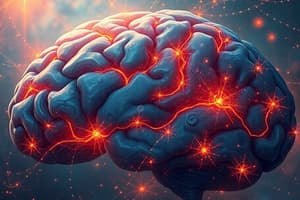Podcast
Questions and Answers
What duration is suggested for short-term memory?
What duration is suggested for short-term memory?
- 30-45 seconds
- 18-30 seconds (correct)
- 10-18 seconds
- 5-10 seconds
What did Wagnaar's research imply about long-term memory capacity?
What did Wagnaar's research imply about long-term memory capacity?
- It is very large. (correct)
- It has a limited capacity.
- It can hold a moderate amount of information.
- It necessitates frequent rehearsal.
What does Bahrick’s study suggest about the duration of long-term memory?
What does Bahrick’s study suggest about the duration of long-term memory?
- It has a limited duration.
- It lasts only a few months.
- It lasts approximately 5 years.
- It is potentially unlimited. (correct)
Which of the following is a limitation of memory research mentioned?
Which of the following is a limitation of memory research mentioned?
What is a criticism of the multi-store model of memory?
What is a criticism of the multi-store model of memory?
Which processing technique is used to move information from sensory register to short-term memory?
Which processing technique is used to move information from sensory register to short-term memory?
What is the primary coding format for short-term memory?
What is the primary coding format for short-term memory?
What is the capacity of short-term memory according to Jacobs' research?
What is the capacity of short-term memory according to Jacobs' research?
Which of the following factors does not lead to the loss of information in short-term memory?
Which of the following factors does not lead to the loss of information in short-term memory?
What type of coding does long-term memory primarily utilize?
What type of coding does long-term memory primarily utilize?
Which research study demonstrated the separation of long-term and short-term memory processes?
Which research study demonstrated the separation of long-term and short-term memory processes?
Which of the following is a characteristic of the sensory register?
Which of the following is a characteristic of the sensory register?
How can chunking affect short-term memory capacity?
How can chunking affect short-term memory capacity?
Flashcards
Multi-Store Model of Memory
Multi-Store Model of Memory
A model of memory that suggests there are three distinct stores: sensory register, short-term memory, and long-term memory.
Coding in Memory
Coding in Memory
The format in which information is stored in each memory store. For example, sensory memory is modality specific, short-term memory is acoustic, and long-term memory is semantic.
Capacity of Memory Stores
Capacity of Memory Stores
The amount of information each memory store can hold. For example, sensory memory has a very large capacity, short-term memory has a limited capacity (around 7 items), and long-term memory has a potentially unlimited capacity.
Duration of Memory Stores
Duration of Memory Stores
Signup and view all the flashcards
Sensory Register
Sensory Register
Signup and view all the flashcards
Short-Term Memory (STM)
Short-Term Memory (STM)
Signup and view all the flashcards
Long-Term Memory (LTM)
Long-Term Memory (LTM)
Signup and view all the flashcards
Maintenance Rehearsal
Maintenance Rehearsal
Signup and view all the flashcards
Short-Term Memory
Short-Term Memory
Signup and view all the flashcards
Long-Term Memory
Long-Term Memory
Signup and view all the flashcards
Ecological Validity
Ecological Validity
Signup and view all the flashcards
Simplicity of the Multi-Store Model
Simplicity of the Multi-Store Model
Signup and view all the flashcards
Evolutionary Theory of Memory
Evolutionary Theory of Memory
Signup and view all the flashcards
Study Notes
Multi-Store Model of Memory
- Developed by Atkinson and Shiffrin in 1968.
- An information processing model.
- A linear model.
- Represents memory as passive stores.
- Consists of sensory register, short-term memory, and long-term memory.
Three Key Features of Each Store
- Coding: The format in which information is stored.
- Capacity: The amount of information each store can hold.
- Duration: How long information is retained in each store.
Sensory Register
- Coding: Modality-specific, meaning it depends on the sense organ (e.g., visual, auditory).
- Capacity: Potentially unlimited, very large.
- Duration: Extremely short, around 250 milliseconds.
Short Term Memory
- Coding: Primarily acoustic (sound-based).
- Capacity: Approximately 7 items, plus or minus 2.
- Duration: 18-30 seconds.
Long Term Memory
- Coding: Primarily semantic (meaning-based).
- Capacity: Potentially unlimited, very large.
- Duration: Potentially unlimited, very large.
Moving Information Between Stores
- Attention: Transfers information from the sensory register to short-term memory.
- Maintenance Rehearsal: Repeating information to keep it in short-term memory, aiding transfer to long-term memory.
- Elaborative Rehearsal: Connecting new information with existing knowledge in long-term memory to enhance memory encoding..
- Displacement: New information pushes out older information in short-term memory.
- Decay: Information fades over time without rehearsal.
Research Evidence for the Multi-Store Model
- Glanzer (1966): The primacy-recency effect points to separate processes for long-term and short-term memory.
- Sperling: Demonstrating the large capacity of sensory memory through partial report experiments, showing a capacity greater than short-term memory.
- Baddeley: Demonstrated acoustic coding in short-term memory and semantic coding in long-term memory by comparing recall of word lists.
- Jacobs: Empirically showing the capacity of short-term memory to be similar to 7 items +/-2.
- Miller: Introduces the concept of chunking, explaining how items can be mentally grouped together to increase short-term memory capacity.
- Peterson & Peterson: Using trigrams and a backward counting task, determined the duration of short-term memory.
- Wagenaar: His long-term memory study of his diary showed high recall after a year and 5 years, highlighting the capacity of long-term memory.
- Bahrick: Using photographs of school friends, his study supports the high recall duration of long-term memory even after an extended time, demonstrating potentially unlimited duration.
Additional Evaluations
- Limitations of research: Many studies are artificial, lacking ecological validity and mundane realism.
- Inference: Inferences about memory based on experimental behaviour can be inaccurate.
- Evolutionary theory: The large capacity and short duration of the sensory register aligns with evolutionary principles and our need to rapidly process sensory information.
- Simplicity of the model: The model is overly simplistic, as short-term and long-term memory are not entirely passive or unitary. Modern views recognise a more active role in both types of memory.
- Face validity: Some assumptions, like the fixed capacity of short-term memory, lack face validity. Memories for smell and taste are possible in the long-term, differing from the model's predictions.
Studying That Suits You
Use AI to generate personalized quizzes and flashcards to suit your learning preferences.




